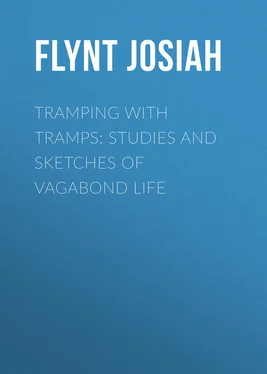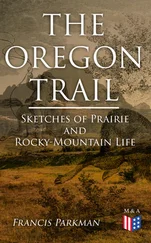Josiah Flynt - Tramping with Tramps - Studies and Sketches of Vagabond Life
Здесь есть возможность читать онлайн «Josiah Flynt - Tramping with Tramps - Studies and Sketches of Vagabond Life» — ознакомительный отрывок электронной книги совершенно бесплатно, а после прочтения отрывка купить полную версию. В некоторых случаях можно слушать аудио, скачать через торрент в формате fb2 и присутствует краткое содержание. Жанр: foreign_antique, foreign_prose, на английском языке. Описание произведения, (предисловие) а так же отзывы посетителей доступны на портале библиотеки ЛибКат.
- Название:Tramping with Tramps: Studies and Sketches of Vagabond Life
- Автор:
- Жанр:
- Год:неизвестен
- ISBN:нет данных
- Рейтинг книги:3 / 5. Голосов: 1
-
Избранное:Добавить в избранное
- Отзывы:
-
Ваша оценка:
- 60
- 1
- 2
- 3
- 4
- 5
Tramping with Tramps: Studies and Sketches of Vagabond Life: краткое содержание, описание и аннотация
Предлагаем к чтению аннотацию, описание, краткое содержание или предисловие (зависит от того, что написал сам автор книги «Tramping with Tramps: Studies and Sketches of Vagabond Life»). Если вы не нашли необходимую информацию о книге — напишите в комментариях, мы постараемся отыскать её.
Tramping with Tramps: Studies and Sketches of Vagabond Life — читать онлайн ознакомительный отрывок
Ниже представлен текст книги, разбитый по страницам. Система сохранения места последней прочитанной страницы, позволяет с удобством читать онлайн бесплатно книгу «Tramping with Tramps: Studies and Sketches of Vagabond Life», без необходимости каждый раз заново искать на чём Вы остановились. Поставьте закладку, и сможете в любой момент перейти на страницу, на которой закончили чтение.
Интервал:
Закладка:
Another kind of ragamuffin, also born on the road, and in many ways akin to the ambulanter, although wanting such classification, is the one found so often in those families which every community supports, but relegates to its uttermost boundary-lines. They are known as "the McCarthys," "the Night-Hawks," or "the Holy Frights," as the case may be. I have found no town in the United States of twenty thousand inhabitants without some such little Whitechapel in its vicinity, and, like the famous original, it is often considered dangerous to enter unarmed. Speaking generally, there is a great deal of fiction afloat concerning these tabooed families, a number of them being simply poor or lazy people whom the boys of the vicinity have exaggerated into gangs of desperados. There are, however, some that are really very bad, and I have found them even in new little villages. They are not exactly out-and-out criminals whom the police can get hold of, but moral lepers who by public consent have been sentenced to live without the pale of civilization.
Some years ago I had occasion to visit one of these miniature Whitechapels. It was situated in a piece of woods not far from St. Paul, Minnesota, and belonged by right of appropriation to three families who were called "the Stansons." A tramp friend of mine had been taken sick in their camp, and I was in duty bound to go out to see him. I managed to find the settlement all right, but was stopped about a hundred yards from the log shanties by a bushy-bearded man, barefooted and clad only in trousers, who asked my errand. My story evidently satisfied him, for he led the way to the largest of the shanties, where I found my friend. He was lying in the middle of the floor on some straw, the only furniture in the room being a shaky table and a three-legged chair. All about him, some even lying in the straw beside him, were half-clothed children of both sexes, playing "craps" and eating hunks of bread well daubed with molasses. I counted nine in that shanty alone, and about as many again in the other two. They belonged severally to six women who were apportioned after Mormon custom to three men. The tramp told me in his dialect that they really were Mormons and came from Utah. He was passing by their "hang-out," as he called it, when taken ill, and they hospitably lodged him. He said they had not been there long, having come up the river from Des Moines, Iowa, where they had also had a camp; but long enough, I discovered on my return to St. Paul, to acquire a reputation among the city lads for all kinds of "toughness." I suppose they were "tough" when considered from certain viewpoints, but, as the tramp said, it was the silliest kind he had known. They were not thieves, and only luke-warm beggars, but they did seem to love their outlandish existence. The children interested me especially, for they all spoke a queer jargon which they themselves had invented. It was something like the well-known "pig Latin" that all sorts of children like to play with, but much more complicated and difficult to understand. And, except the very youngest, who naturally cried a little, they were the jolliest children I have ever seen in such terrible circumstances. The mothers were the main breadwinners, and while I was there one of them started off to town on a begging trip, with a batch of children as "guy." The men sat around, smoked, and talked about the woods. The tramp told me later, however, that they occasionally raided a hen-roost. Since my visit to the Stansons I have seen three of the children in different places: one, a cripple, was begging at the World's Fair; another was knocking about the Bowery; and the third, a girl, was traveling with an ambulanter in the Mohawk valley.
Not all of these families are like the Stansons. A number are simply rough-and-tumble people who haunt the outskirts of provincial towns, and live partly by pilfering and partly from the municipal fund for the poor. Somehow or other the children always dodge the school commissioners, and grow up, I am sorry to say, very much like their usually unmarried parents. On the other hand, there are several well-known organized bands, and they thrive mainly, I think, in the South and West. Near New Orleans there used to be, and for aught I know they are still there, "the Jim Jams" and "the Rincheros"; near Cairo, Illinois, "the River Rats"; near Chicago, "the Dippers"; and not far from New York, in the Ramapo Mountains, I knew of "the Sliders," but they have since moved on to new fields. Each of these families, or collection of families, had its full quota of children. Very often the public becomes so enraged at their petty thefts that an investigation is ordered, and then there is a sudden packing of traps and quick departure to a different neighborhood, where a new name is invented. But the family itself never dies out entirely.
There are a few children who are born in Hoboland. Now and then, as one travels along the railway lines, he will come to a hastily improvised camp, where a pale, haggard woman is lying, and beside her a puny infant, scarcely clothed, blinking with eyes of wonder upon the new world about him. I know of no sadder sight than this in all trampdom. Not even the accident of motherhood can make the woman anything but unhuman, and the child, if he lives, grows up in a world which I believe is unequaled for certain forms of wickedness. Fortunately, his little body usually tires of the life ere he comes to realize what it is, and his soul wanders back to regions of innocence, unsoiled and unscarred.
I wonder whether there are still men in Hoboland who remember that interesting little fellow called "the Cheyenne Baby"? Surely there are some who have not forgotten his grotesque vocabulary, and his utterly overpowering way of using it. There are different stories concerning his origin, and they vary in truthfulness, I have heard, as one travels southward from the Northern Pacific to Santa Fé. I give the one told in Colorado. It may be only a "ghost-story," and it may be true; all that I know is that it is not impossible. According to its teaching, his mother was once respectable and belonged to the politest society in the Indian Territory. When quite a young girl she carelessly fell in love with a handsome Indian chief, and, much to the disgust of her friends, married him and went away into his camp. It must have been a wild life that she led there, for within a year she was separated from him and living with another Indian. It is the same pitiful story for the next five years; she was knocked about from tent to tent and camp to camp. Her enemies say that she liked that kind of life, but her friends know better, and claim that she was ashamed to go home. However it was, she went over to the cow-boys after a while, and it was then that the baby was born, and she met the man, whoever he was, that introduced her into Hoboland. She appeared one night at a hang-out near Denver, and there was something so peculiarly forlorn about her that the men took pity on her and pressed her to stay. This she did, and for some time traveled with the hoboes throughout the districts lying between Cheyenne and Santa Fé. The boy became a sort of "mascot," and was probably the only child in Hoboland who was ever taught to be really good. The mother had stipulated with the men that they should never teach him anything bad, and the idea struck them as so comical that they fell in with it. Though they swore continually in his presence, they invariably gave him some respectable version of the conversation; and while about the only words he knew were curses, he was made to believe they signified the nicest things in the world. He died just as unknowing as he had lived, but it was a cruel death. He and his mother, together with some companions, were caught one night in a wreck on the Union Pacific, and all that the survivors could find of him to bury was his right arm. But that was bravely honored, and, unless the coyotes have torn down the wooden slab, the grave can still be found on the prairies.
Читать дальшеИнтервал:
Закладка:
Похожие книги на «Tramping with Tramps: Studies and Sketches of Vagabond Life»
Представляем Вашему вниманию похожие книги на «Tramping with Tramps: Studies and Sketches of Vagabond Life» списком для выбора. Мы отобрали схожую по названию и смыслу литературу в надежде предоставить читателям больше вариантов отыскать новые, интересные, ещё непрочитанные произведения.
Обсуждение, отзывы о книге «Tramping with Tramps: Studies and Sketches of Vagabond Life» и просто собственные мнения читателей. Оставьте ваши комментарии, напишите, что Вы думаете о произведении, его смысле или главных героях. Укажите что конкретно понравилось, а что нет, и почему Вы так считаете.












